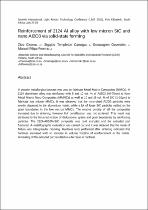 ResearchSpace
ResearchSpace
Reinforcement of 2124 Al alloy with low micron SiC and nano Al2O3 via solid-state forming
JavaScript is disabled for your browser. Some features of this site may not work without it.
- ResearchSpace
- →
- Research Publications/Outputs
- →
- Conference Publications
- →
- View Item
| dc.contributor.author |
Gxowa, Z

|
|
| dc.contributor.author |
Camagu, ST

|
|
| dc.contributor.author |
Govender, S

|
|
| dc.contributor.author |
Pereira, MF

|
|
| dc.date.accessioned | 2016-10-03T10:35:53Z | |
| dc.date.available | 2016-10-03T10:35:53Z | |
| dc.date.issued | 2015-07 | |
| dc.identifier.citation | Gxowa, Z., Camagu, S.T., Govender, S. and Pereira, M.F. 2015. Reinforcement of 2124 Al alloy with low micron SiC and nano Al2O3 via solid-state forming. In: Seventh International Light Metals Technology Conference (LMT 2015), Port Elizabeth, South Africa, July 27-29 | en_US |
| dc.identifier.uri | http://www.scientific.net/MSF.828-829.172 | |
| dc.identifier.uri | http://hdl.handle.net/10204/8775 | |
| dc.description | Seventh International Light Metals Technology Conference (LMT 2015), Port Elizabeth, South Africa, July 27-29. Due to copyright restrictions, the attached PDF file only contains the abstract of the full text item. For access to the full text item, please consult the publisher's website | en_US |
| dc.description.abstract | A powder metallurgical process was used to fabricate Metal Matrix Composites (MMCs). A 2124 aluminium alloy was reinforced with 5 and 10 vol. % of Al2O3 (40-70nm) to form Metal Matrix Nano Composites (MMNCs) as well as 10 and 15 vol. % of SiC (1-10µm) to fabricate low micron MMCs. It was observed that the nano-sized Al2O3 particles were evenly dispersed in the aluminium matrix while a lot of loose SiC particles settled on the grain boundaries in the low micron MMCs. The relative density of all the composites increased due to sintering, however full densification was not achieved. This result was attributed to the hindered motion of dislocations, grains and grain boundaries by reinforcing particles. The 2124-Al/10%-SiC composite was cold extruded and the extruded part fractured. A metallographic evaluation was carried out and it was deduced that the mode of failure was intergranular cracking. Hardness tests performed after sintering indicated that hardness increased with an increase in volume fraction of reinforcement in the matrix. Annealing of the extruded part resulted in a decrease in hardness. | en_US |
| dc.language.iso | en | en_US |
| dc.publisher | Trans Tech Publication | en_US |
| dc.relation.ispartofseries | Workflow;15435 | |
| dc.subject | Al/Al2O3 nanocomposite | en_US |
| dc.subject | Al/SiC composite | en_US |
| dc.subject | Powder metallurgy | en_US |
| dc.subject | Sinterability | en_US |
| dc.subject | Hardness | en_US |
| dc.title | Reinforcement of 2124 Al alloy with low micron SiC and nano Al2O3 via solid-state forming | en_US |
| dc.type | Conference Presentation | en_US |
| dc.identifier.apacitation | Gxowa, Z., Camagu, S., Govender, S., & Pereira, M. (2015). Reinforcement of 2124 Al alloy with low micron SiC and nano Al2O3 via solid-state forming. Trans Tech Publication. http://hdl.handle.net/10204/8775 | en_ZA |
| dc.identifier.chicagocitation | Gxowa, Z, ST Camagu, S Govender, and MF Pereira. "Reinforcement of 2124 Al alloy with low micron SiC and nano Al2O3 via solid-state forming." (2015): http://hdl.handle.net/10204/8775 | en_ZA |
| dc.identifier.vancouvercitation | Gxowa Z, Camagu S, Govender S, Pereira M, Reinforcement of 2124 Al alloy with low micron SiC and nano Al2O3 via solid-state forming; Trans Tech Publication; 2015. http://hdl.handle.net/10204/8775 . | en_ZA |
| dc.identifier.ris | TY - Conference Presentation AU - Gxowa, Z AU - Camagu, ST AU - Govender, S AU - Pereira, MF AB - A powder metallurgical process was used to fabricate Metal Matrix Composites (MMCs). A 2124 aluminium alloy was reinforced with 5 and 10 vol. % of Al2O3 (40-70nm) to form Metal Matrix Nano Composites (MMNCs) as well as 10 and 15 vol. % of SiC (1-10µm) to fabricate low micron MMCs. It was observed that the nano-sized Al2O3 particles were evenly dispersed in the aluminium matrix while a lot of loose SiC particles settled on the grain boundaries in the low micron MMCs. The relative density of all the composites increased due to sintering, however full densification was not achieved. This result was attributed to the hindered motion of dislocations, grains and grain boundaries by reinforcing particles. The 2124-Al/10%-SiC composite was cold extruded and the extruded part fractured. A metallographic evaluation was carried out and it was deduced that the mode of failure was intergranular cracking. Hardness tests performed after sintering indicated that hardness increased with an increase in volume fraction of reinforcement in the matrix. Annealing of the extruded part resulted in a decrease in hardness. DA - 2015-07 DB - ResearchSpace DP - CSIR KW - Al/Al2O3 nanocomposite KW - Al/SiC composite KW - Powder metallurgy KW - Sinterability KW - Hardness LK - https://researchspace.csir.co.za PY - 2015 T1 - Reinforcement of 2124 Al alloy with low micron SiC and nano Al2O3 via solid-state forming TI - Reinforcement of 2124 Al alloy with low micron SiC and nano Al2O3 via solid-state forming UR - http://hdl.handle.net/10204/8775 ER - | en_ZA |





